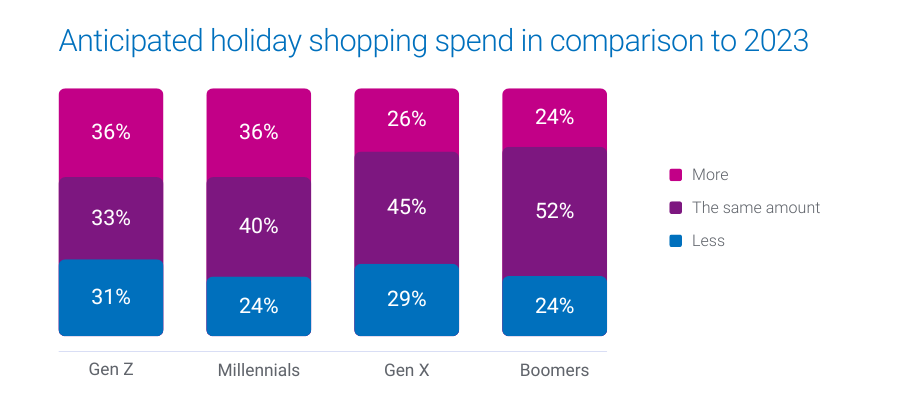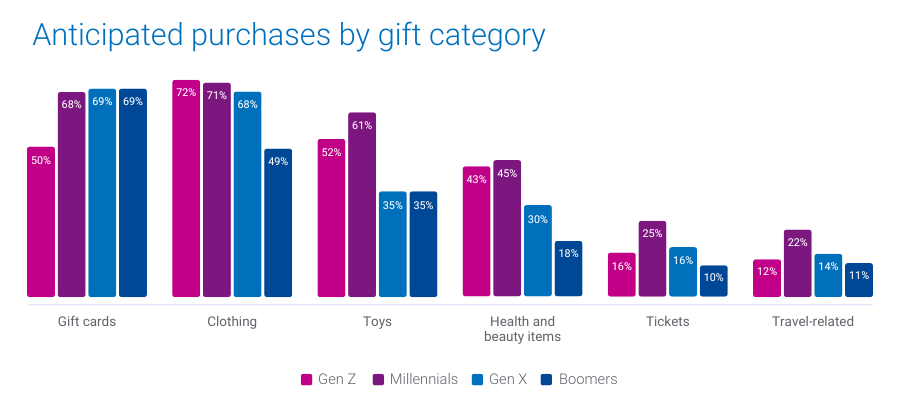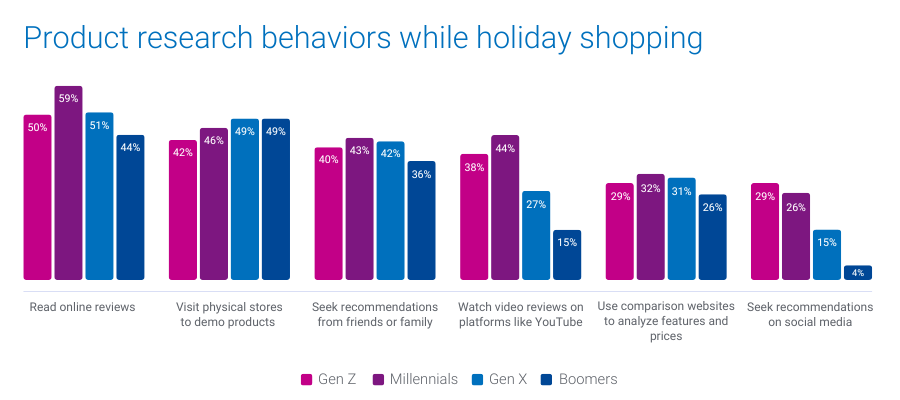
The holiday season is almost here, and knowing how each generation plans to shop can give your holiday advertising campaigns the edge you need. Our recent survey of 1,000 U.S. consumers reveals 2024 holiday shopping trends for each generation and key insights into their anticipated spending levels, preferred shopping categories, and how they look for gift ideas.
In this blog post, we’ll explore three 2024 holiday shopping trends across generations:
- Projected consumer spending
- Top categories on shoppers’ lists
- Preferred channels for researching gifts
1. Projected consumer spending
Over 1 in 3 Gen Z and Millennials are gearing up to increase their holiday budgets this year, while Gen X and Boomers are likelier to stick to last year’s budget.
- 36% of Millennials and Gen Z plan to spend more this holiday season
- 45% of Gen X and 52% of Boomers expect their spending to remain consistent with last year

What this means for marketers
These insights highlight the importance of tailoring your messaging. For Gen Z and Millennials, emphasize value and unique offerings that justify increased spending. For Gen X and Boomers, focus on trust and reliability, reinforcing their confidence in your brand.
How Experian can help you target these audiences
Experian’s custom and syndicated audience segments, including Holiday Shopper High Spenders and Holiday Shopper Moderate Spenders, enable you to connect with these diverse consumer groups. Our audiences are available on-the-shelf of leading ad platforms to help you reach people across social, TV, and mobile.
The election effect
U.S. holiday retail sales saw 4.1% YoY growth in 2016 and 8.3% YoY growth in 2020 following presidential elections. There’s a chance that holiday spending increases after the 2024 election, regardless of the outcome. Experian has 240+ politically relevant audiences that you can activate across major ad platforms ahead of the upcoming election.
2. Top categories on shoppers’ lists
Different generations have distinct preferences when it comes to what they plan to buy. Gift cards top the list for Gen X and Boomers, while Gen Z leans toward clothing. Millennials are looking to splurge on toys, electronics, and experiences.
- 69% of Boomers and Gen X plan to purchase gift cards
- 72% of Gen Z will buy clothing
- 45% of Millennials will buy health and beauty items
- 25% of Millennials will buy tickets and 22% of Millennials will buy experiences

What this means for marketers
Align your product offerings and promotions with each generation’s preferences to capture their attention. For example, highlighting versatile gift cards may resonate more with older generations, while showcasing trendy apparel and tech gadgets will appeal to younger consumers.
How Experian can help you target these shoppers
We offer audience segments like Holiday Shoppers: Apparel, Cosmetics & Beauty Spenders, and Toys Shoppers that you can activate to connect with consumers primed to purchase in these categories.
We recently released 19 new holiday shopping audiences we recommend targeting to drive engagement and conversions. Download our audience recommendations here.
3. Preferred channels for researching gift ideas
When it comes to finding the perfect gifts, Gen Z turns to social media, while Millennials prefer online reviews and video content. Boomers and Gen X are more inclined to visit physical stores for hands-on product evaluations.
- 29% of Gen Z and 26% of Millennials will look for gift ideas on social media
- 44% of Millennials will rely on video reviews and product demos on platforms like YouTube
- 49% of Gen X and Boomers plan to visit physical stores to evaluate products in person

What this means for marketers
Understanding where each generation looks for inspiration can guide your content and ad placement strategy. To engage Gen Z, focus on social media campaigns and influencer partnerships. For Millennials, consider investing in video content and reviews. For older generations, ensure your in-store experience is optimized to convert browsing into purchases.
How Experian can help you engage these shoppers
Our TrueTouchTM audiences can help you pair the perfect messaging styles with the right channels and calls to action. Our Social media channel and content engagement audiences can help you reach Gen Z who are likely to be active users on major social platforms and are Black Friday shoppers. For a full list of Experian’s syndicated audiences and activation destinations, download our syndicated audiences guide.
Download our report for five 2024 holiday shopping trends by generation
Understanding 2024 holiday shopping trends by generation can help you tailor your targeting, messaging, media planning, and creative based on the generation you’re targeting.
In addition to the insights covered here, download our 2024 Holiday spending trends and insights report to learn:
- When consumers plan to shop (hint: they’re already shopping)
- Where they plan to shop (online vs. in-store)
Download our full report to access all five of our predictions by generation, so you can address the diverse needs of this year’s holiday shoppers.
When you work with Experian for your holiday shopping campaigns, you’re getting:
- Accurate consumer insights: Better understand your customers’ behavioral and demographic attributes with our #1 ranked data covering the full U.S. population.
- Signal-agnostic identity solutions: Our deep understanding of people in the offline and digital worlds provides you with a persistent linkage of personally identifiable information (PII) data and digital IDs, ensuring you accurate cross-device targeting, addressability and measurement.
- Secure connectivity: Bring data and identity to life in a way that meets your needs by securely sharing data between partners, utilizing the integrations we have across the ecosystem, and using our marketing data in flexible ways.
Make the most of this holiday shopping season with Experian. Contact us today to get started.
Source
Online survey conducted in June, 2024 among n=1,000 U.S. adults 18+. Sample balanced to look like the general population on key demographics (age, gender, household income, ethnicity, and region).
Latest posts

Adam Garone is the CEO & co-founder of Movember, the annual world-wide charity movement dedicated to changing the face of men's health – all through the power of the moustache. To date, over 3 million moustaches have been grown and supported for Movember, raising more than $440 million to change the face of men's health. Adam kicked off day two of the EMS Client Summit by saying he’s a lucky guy because he gets “to wear a 1993 porn stash year-round.” That line got a laugh, but Adam’s storytelling around Movember really caught the attention of Summit attendees. Adam had learned that prostate cancer affects as many men as breast cancer does women, and while discussing this fact over beers with his brother in Australia, the idea for Movember was born. They took the Aussie slang for moustache (“mo”) and combined it with “November” (a good month for men to grow them) to create the name. That was in 2003 and over the last decade, Movember has become a global movement around prostate and testicular cancer awareness, as well as men’s mental health issues. Watch his full presentation below: [Watch video on YouTube] Here are some cool facts cited by Adam: Everyone who grows a moustache for Movember is a “celebrity ambassador.” Last year, 2.7 billion conversations about Movember and men’s health issues were generated during the month of November. Most foundations go out with a “fear-based message” (x number of men die from cancer each year, for example). Movember has never done that. They encourage nicknames (i.e., participants are called “mo-bros”) and want people to have fun with it. Adam’s message: don’t be part of it because you’re scared, but because you will be fine and you get to help others. Each year they totally revamp their brand, changing the look, feel and tone. A few years ago their theme was “The Modern Gentleman” and last year it was “Movember and Sons,” and played off the relationship between father and son. Movember raised $145 million last year. They put 10% of the funds into a pool that goes towards research around other diseases. Adam says this kind of collaboration is to help reduce the heaving competition amongst charities that typically compete for donations. Key takeaways when it comes to growing a foundation (or business) from the ground up: Start with a great idea – naivety is good Rely on strong leadership –have a clear vision and detailed plan and work really, really hard Recruit amazing people – preserve culture and values During rapid growth, keep it simple—stay true to your core Brand management is key – sometimes you have to say no to potential partners because they don’t fit with your brand (in a humble way, of course) Know your customers – inspire them to become your ambassadors Partnerships are key Never underestimate a room full of people

These days, there are a number of buzzwords being thrown around the marketing industry and the data management space. One of the biggest? Say it with me: Big Data. NPR argued last December that ‘big data’ should’ve been the “word of the year,” in part due to the re-election of President Barack Obama. Obama’s campaign managers didn’t let the Republicans’ monetary advantage discourage them. Instead, they gathered information on their voters and compiled important analytics based on that information. By handling this mass of data in an organized and well thought out process, they were able to more effectively appeal to voters and ultimately win the re-election. Marketers and corporations across the country were inspired by the campaign’s success, and have turned to big data to solve their problems as well. Anyone who catches the news on a regular basis, shops online, or owns a smartphone can see this evolution firsthand. However, it’s worth mentioning that this progression doesn’t necessarily mean “big understanding” or “big information.” Many companies are faltering in their efforts to harness big data and make real use of it. The pool of information is constantly changing, and as so many businesses rush to gather the data in real-time, it becomes even more challenging to keep pace and actively comprehend information as it becomes available. And the challenges go beyond the initial harnessing of the data. As big data continues to grow, companies are running into issues of incorrect and duplicate data in their systems. This erroneous data is a result of poor processes that companies have in place, and oftentimes begins at the point of data input. For a number of companies, data input is performed on a daily basis via their call centers. When incorrect data is recorded, it prevents sales representatives from getting leads in a timely manner, and hampers them further when they try to contact the correct individuals seeking assistance. The resulting slower response time then goes on to impact a company’s SLA and credibility to the population they serve. There is no doubt that when processed correctly, big data can be integral to a company looking to improve their understanding of the customer’s needs and wants. But data quality is an important consideration during the transition, and one that must be confronted before big data can reveal all it has to offer. To learn more about big data and how it relates to the data quality initiatives that may be taking place within your organization, watch Experian QAS’ webinar, “Ensuring Data Quality in your Big Data Initiative.” Learn more about the author, Erin Haselkorn

2013 has been a milestone year for those lobbying on behalf of expanded rights of Lesbian, Gay, Bisexual and Transgendered (LGBT) Americans. With 12 states and the District of Columbia now formally recognizing same sex marriages and two highly anticipated rulings from the U.S. Supreme Court expected shortly, the momentum is currently on the side of those seeking greater recognition and support of LGBT-related issues. The speed with which public attitudes have shifted towards greater acceptance of LGBT individuals and their causes has left many marketers scrambling to devise plans that are not only inclusive of LGBT consumers, but in many instances, designed to overtly and publically court this influential and growing consumer segment. The 2013 LGBT consumer report out from Experian Marketing Services delivers insights marketers need to better understand the market that is on everyone’s radar. In this first of a series of blog posts, we’ll highlight key data from the report. Readers can download the full report at any time here. Living out Loud In 2006, when Experian Marketing Services first began measuring sexual orientation among respondents to our Simmons® National Consumer Study, we found that 3.4% of all non-Hispanic adults self-identified as either lesbian, gay, bisexual or transgendered (LGBT), a figure consistent with what leading LGBT researchers predicted at the time. However today, 4.3% of the non-Hispanic adult population self-identifies as LGBT, a figure that has risen slowly but steadily year-after-year. Younger adults have consistently been more likely to identify as LGBT, and in fact today, 5.8 percent of 18 to 34 year olds say they are lesbian, gay, bisexual or transgendered. As a result, the adult LGBT population predictably skews towards the younger age cohorts. Specifically, 36% of LGBT adults today are aged 18 to 34 versus 26% of the heterosexual population in that age range. Likewise, while 20% of heterosexual adults are age 65 and older, just 16% of LGBT adults are in this age range, though our data shows that the share of adults age 65 and older identifying as LGBT has also risen. Home and Family As a growing number of U.S. states pass laws recognizing same-sex marriages and civil unions, we see an increasing percentage of gay and lesbian Americans reporting that they are married. In 2007, for example, when only Massachusetts allowed same-sex marriage, 8% of gay men and 14% of lesbian women said they were married. Today, 17% of gay men and 16% of lesbian women are married. Marriage rates among lesbian and gay adults still lag well behind those of heterosexuals, but the gap is closing from both sides. In fact, while marriage rates are rising among lesbians and gays, they’re falling among heterosexuals. Today, 58% of heterosexual men and 53% of heterosexual women are married, compared to 60% of heterosexual men and 55% of heterosexual women who were married in 2007. The Pink Dollar Income levels are important to consider when targeting consumers, but more important is determining the amount of money left over for non-essentials after the other bills are paid. Despite earning nearly identical salaries, gay men have lower annual household discretionary expenditures than heterosexual men. Likewise, lesbian households have fewer dollars than those of heterosexual women to spend on non-essentials. This is mostly likely due to the fact that both lesbian and gay adults tend to reside in larger cities where the cost of living can be considerably higher than average. Interestingly, when household size is brought into the equation, we see that gay males actually have higher discretionary spending per capita than heterosexual men. In fact, gay men live in households that devote $6,794 per capita annually to non-essentials, which is $753 more than what heterosexual men spend. Forthcoming posts from this series will include insights into the automotive and food vertical markets; the mobile habits of LGBT consumers; and an examination of online visitors to LGBT content sites. Don’t want to wait? Download the full report now. Also, learn more about the Simmons LGBT Consumer Study, the only syndicated, national probability sample survey that measures the lifestyles, attitudes, media habits and brand preferences of the LGBT population giving marketers actionable insights into this powerful consumer segment that can be directly compared with those of heterosexuals.